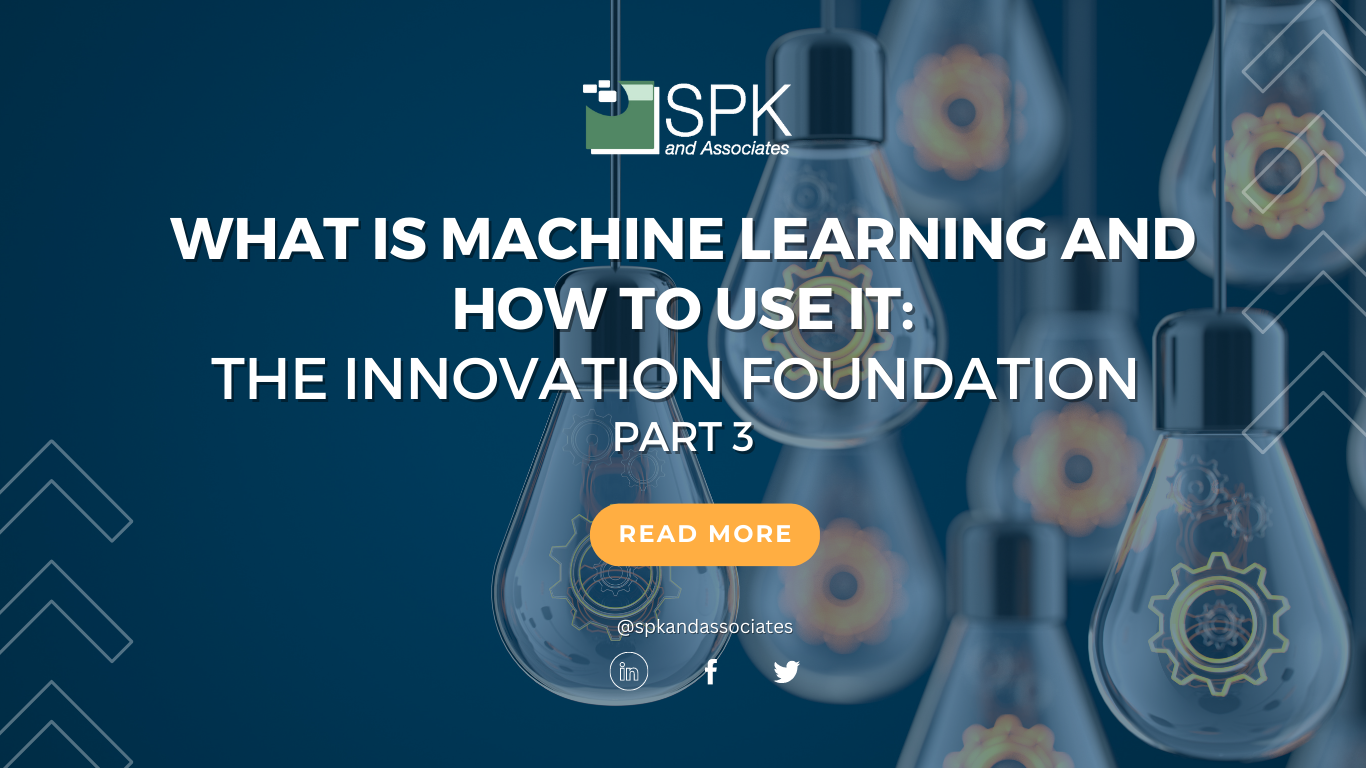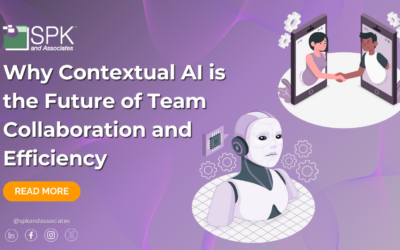From the moment we enter this world, learning becomes an innate part of our existence. Our brains constantly absorb new information, forming neural pathways that shape our understanding and actions. In a similar vein, Machine Learning (ML) serves as the brain of a computer, employing networks that train, acquire knowledge and act. So, in this instalment of our Innovation Foundation series, we’re exploring the Machine Learning basics: what is Machine Learning? How do you use it? And how is it linked to Big Data, Cloud and Artificial Intelligence (AI)?
Firstly though, if you’re interested in delving into the history of Machine Learning, Big Data, Cloud, and AI, read part one and part two of this series.
Explained: The Basics Of Machine Learning
What Is Machine Learning?
Machine learning is a remarkable technology enabling computers to learn and make decisions independently, without explicit programming.
Similarly to how we learn from examples, machine learning algorithms learn from data. Then, they use that data to identify patterns and make predictions. For example, when training a computer to recognize animals, we provide it with various animal images and their corresponding labels. Through analysis, the computer establishes its own rules for distinguishing different animals. Consequently, when presented with new images, it can apply its learned knowledge to identify the type of animal depicted.
And, this capability has diverse applications. For example, self-driving cars, virtual assistants, and video game character behavior. Basically, Machine Learning enables computers to continuously improve and adapt as they gather more data. Additionally, its broad spectrum of use is already revolutionizing numerous industries and shaping our future.

Is Machine Learning And AI The Same?
Machine learning and Artificial Intelligence (AI) are interconnected concepts. Yet, they possess distinct characteristics. AI encompasses a broader domain that aims to construct intelligent systems mirroring human intellect. It encompasses diverse methodologies like machine learning, expert systems, and symbolic reasoning. Essentially, this enables the performance of tasks necessitating human-like intelligence.
Conversely, Machine Learning operates within the realm of AI as a subset. Its primary focus revolves around instructing computers to learn from data without explicit programming. Essentially, Machine learning empowers computers to understand patterns and make data-driven decisions through algorithmic improvement with experience.
Machine Learning Basics: How Does It Use Big Data And Cloud?
Now, imagine you have a huge amount of data coming from different sources, like social media, sensors, or online transactions. This is what we call Big Data. So, to make sense of all that data, we can use machine learning to learn, find patterns, and make smart decisions.
But, the data Machine Learning needs to learn is vast! So, we need somewhere that can store unfathomable amounts of data and solid computing power. That’s where Cloud services, like AWS and Azure, come into play. Cloud services can process and analyze data much faster and more efficiently.

When we combine big data, machine learning, and cloud computing, we get a supercharged system. Machine learning learns from the big data stored in the cloud and makes predictions or decisions based on what it learned. And, this helps us make sense of the data and gain valuable insights. This combination of technologies has transformed many industries. From personalized recommendations on streaming platforms to self-driving cars and more.
The Key Components Needed For Successful Applications
Like anything that learns, the outputs are only as good as the inputs. And, for a successful Machine Learning application, you need these three key components:
- Data is the foundation of machine learning. You’ll need high-quality, relevant, and properly labeled data for training machine learning models.
- Choosing the right algorithm for a specific task is key to achieving optimal performance. There are various algorithms available, each with its strengths and limitations, such as decision trees, neural networks, support vector machines, and random forests.
- Vast computing power is needed to process and analyze large volumes of data, train complex models, and make predictions in a timely manner. So, you’ll need access to powerful processors, parallel computing, and distributed systems like those provided by AWS and Azure. Check out the difference between AWS and Azure here.
An Intermediate Understanding Of Machine Learning
So, now we have a better understanding of the basics of Machine Learning, let’s look at it in more depth.
Types of Machine Learning Systems:
There are four key models in Machine Learning (ML). These different branches offer a powerful set of tools and techniques to solve a wide range of real-world problems. Ultimately, they drive innovation across various domains.
1. What Is Supervised Learning?
Supervised learning trains models using labeled data to make predictions or classifications. Algorithms like linear regression, support vector machines (SVM), and random forests find patterns in labeled data and apply them to new data. This approach is used in:
- Healthcare for disease prediction.
- Finance for credit scoring.
- Customer churn prediction to retain customers.
2. What Unsupervised Learning?
Unsupervised learning is an important part of machine learning where we work with data that doesn’t have any labels or categories. Basically, it’s like solving a puzzle without knowing what the final picture looks like. Instead of being given specific instructions, we let the computer figure things out on its own.
There are special algorithms that help us find patterns and group similar data together. And these algorithms can identify different types of customers based on their buying habits. Or detect unusual patterns in network traffic for cybersecurity. Additionally, it can recommend products or movies based on what you like.
3. What Is Reinforcement Learning?
Reinforcement learning is an exciting branch of machine learning where machines learn through trial and error. The process involves the machine interacting with its environment. Then it takes action and receives feedback in the form of rewards or penalties. Basically, through this feedback loop, the machine learns to make better decisions over time.
Reinforcement learning finds applications in various domains, such as robotics, game-playing, and autonomous systems. For example, it can be used to:
- Train a robot to navigate through a complex environment.
- Play games like chess or Go at a high level
- Enable autonomous vehicles to make intelligent decisions while driving.
4. What Is Deep Learning?
Deep learning is a subset of Machine Learning focused on using neural networks, inspired by the human brain, to tackle complex data patterns. Additionally, Convolutional Neural Networks (CNNs) are great for image tasks like recognizing objects. And Recurrent Neural Networks (RNNs) excel at sequential data like speech or language. Finally, transformer models have revolutionized tasks like language translation and sentiment analysis.
Deep learning has made big advancements in image and speech recognition, language translation, and sentiment analysis. Furthermore, recent improvements include:
These are leading to more accurate and efficient models.
Techniques for Effective Machine Learning
But, Machine Learning is more than just building models. Why? Because, it also requires careful consideration of various factors to ensure accurate predictions and meaningful insights. Below are several key aspects that go beyond the ML model itself. These techniques and practices enhance model performance and understanding. By understanding these concepts, you’ll gain valuable insights into how machine learning algorithms can be optimized. And, how the results can be effectively interpreted.
1. Feature Engineering
Feature engineering is the process of selecting and transforming relevant features to improve model training. It involves techniques like:
- One-hot encoding.
- Feature scaling.
- Dimensionality reduction to make data more suitable for machine learning algorithms.
Automated feature engineering frameworks like Featuretools can help extract valuable features automatically. Whereas feature selection techniques like statistical tests and recursive feature elimination aid in identifying informative features for model performance.
2. Cross-Validation
Cross-validation is essential to prevent overfitting and assess model performance. Techniques like k-fold cross-validation and stratified sampling ensure robust evaluation. Next, evaluation metrics like accuracy, precision, recall, and F1 score help measure model effectiveness. And for time-series data, a time-series cross-validation is used to account for temporal differences.
3. Hyperparameter Tuning
Hyperparameter tuning optimizes model performance by adjusting parameters. Techniques like grid search, random search, and Bayesian optimization explore different parameter combinations. Hyperparameter tuning libraries like Optuna and Hyperopt automate the process. Lastly, AutoML frameworks further streamline hyperparameter optimization.
4. Ensembling
Ensembling combines multiple models to improve predictions. Bagging, boosting, and stacking are common ensemble methods. Frameworks like XGBoost, LightGBM, and CatBoost provide efficient implementations. And in deep learning, ensemble techniques like model averaging and stacking can enhance performance.
5. Model Interpretability and Explainability
Model interpretability techniques help understand and explain model predictions. Feature importance analysis, partial dependence plots, and SHAP values reveal the impact of features on predictions. Tools like LIME, SHAP, and ELI5 provide insights into model decisions. However, there is a trade-off between model complexity and interpretability.
Real-World Applications For Machine Learning
As you can imagine, Machine Learning has a never-ending spectrum of opportunities across every industry. For example the basics of Machine Learning in the real world are:
- Machine Learning in the Healthcare industry:
- Plays a vital role in predictive modeling for disease diagnosis and treatment recommendations.
- Enables medical image analysis for early detection of diseases.
- Facilitates personalized medicine and drug discovery.
- Aids in electronic health record (EHR) analysis for patient risk stratification.
- Machine Learning in the Finance sector:
- Machine learning contributes to fraud detection and risk assessment.
- Supports algorithmic trading and portfolio optimization.
- Assists in credit scoring and loan default prediction.
- Enables customer churn prediction and retention strategies.
- Machine Learning in the E-commerce and marketing:
- Machine learning techniques are used for customer segmentation and targeted advertising.
- Demand forecasting and inventory management.
- Recommender systems for personalized product recommendations.
- Sentiment analysis and opinion mining for customer feedback.
- Machine Learning in the Manufacturing and supply chain:
- Facilitates predictive maintenance to minimize downtime.
- Enhances quality control and anomaly detection in production processes.
- Optimizes supply chain operations and demand forecasting.
- Streamlines inventory management and just-in-time (JIT) delivery.
Future Trends in Machine Learning
Next up, There are several exciting trends on the horizon for Machine Learning. For example:
- Advancements in deep learning techniques will lead to even more accurate and sophisticated models.
- Reinforcement learning is gaining traction in solving complex real-world problems, including robotics, autonomous driving, and game playing.
- Edge computing and the integration of Machine Learning with IoT devices will enable real-time analytics, reduced latency, and improved privacy and security.
- Federated learning, which allows collaborative model training while preserving data privacy, will become more prevalent. This is due to more organizations seeking ways to leverage collective intelligence without compromising sensitive data.
- Automation and AutoML will simplify the machine learning pipeline. Essentially, this will make it more accessible to non-experts by automating tasks such as model selection, hyperparameter tuning, and feature engineering.
Finally, there is a note on the ethical considerations within Machine Learning. Machines learn from inputs. Because, as the technology grows, so should the understanding and implications of coded bias and responsible development.
Train Machines With The Right Expertise
Machine Learning requires significant expertise and training for successful model deployment. Data scientists and engineers spend years learning and obtaining certifications to become competent in this field. Ultimately, it necessitates a high level of skill, akin to that of a computer brain surgeon, to create models that learn and behave appropriately. So, if your organization lacks the necessary in-house expertise, partnering with Machine Learning experts is essential to accomplish your goals.







